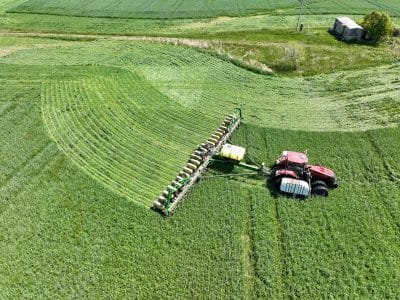It happens like clockwork almost every year, starting in June. Wagons bounce over field ruts, filled with people clutching coffee, a stapled agenda, and – if they’re lucky – maybe a donut or two.
As reliable as the summer solstice, it’s the telltale sign that university field day season has begun! And the valuable content of these field days – ongoing research on herbicides, integrated weed management and new technology – is just as dependable.
To dig into what you can find at these events, and why they’re worth the sunscreen and sweat, we talked with two veteran Weed Science Field Day emcees, University of Delaware Extension weed scientist Mark VanGessel and North Dakota State University weed scientist Joe Ikley.

What Are Field Days?
Universities tend to hold multiple types of field days throughout the growing season to showcase different research projects and findings, so make sure you’re headed to the right one for your interests, VanGessel says. Some field days are focused on a specific discipline (like weed science), some are focused on certain commodities (like small grains or vegetables) and some encompass an entire research station and all the agronomic research happening there.
Generally, field days focused on weed science occur a bit earlier in the summer, in mid-to-late June, depending on your geography, Ikley notes. “That’s a good viewing time to see how chemical programs are working on weeds in real-time, before soybeans canopy and corn gets too tall,” he explains. The larger field days focused on agronomic plots across an entire research station tend to occur later in the season, into July or August.
What Can I Expect to See?
Each university may do things a little differently, but across the board, herbicide trials will be a common feature of a weed science field day, Ikley and VanGessel agree. “The bread and butter of many university research plots are trials from chemical companies trying out a bunch of different herbicide programs or new active ingredients, and trying to show how they fit in our region, with our soil types and weed spectrums,” Ikley says.
You’re also likely to see research trials supported by your state commodity boards, as well as the research that university graduate students are working on, which can involve newer herbicide application technologies and integrated weed management tactics, VanGessel says. And with herbicide resistance becoming more entrenched across the country, attendees can increasingly expect to find research trials on non-chemical tactics such as cover crops or harvest weed seed control.
Who Can Attend?
All are welcome!
“These are usually land-grant, publicly funded researchers, and the mission of land-grant universities is to extend our research and information to a wider audience, so it’s very inclusive as to who can attend,” VanGessel explains.
Field days can draw a pretty broad crowd, but there are some regulars you can expect. Ag chemical company representatives almost always attend, “to see how their own products are working and maybe how the competitor products might be working,” as Ikley notes.
Crop consultants – who are tasked with helping farmers make agronomic and management decisions – are often there, as well as staff from ag-related agencies, such as state departments of agriculture and NRCS. Members of the ag media are not an uncommon sight, either.
Finally, farmers usually make up a portion of the attendees, and this is a group that VanGessel and Ikley always welcome and encourage. “It’s a great informal setting where farmers can relay back to researchers what is happening on their farms or in their area that needs to be addressed through future research,” VanGessel says.
Weed science field days are also a chance for farmers to have hands-on experience with valuable research, Ikley adds. “You get to see with your own eyes how some things are working – a herbicide product or a program, for example,” he says. “We always have untreated checks there, so you can actually make your own independent assessments based on what you’re seeing.”

How Accessible Are Field Days?
The researchers and research stations that host field days work hard to make them as accessible as possible, both Ikley and VanGessel agree. They are almost always free to attend, and if you’re lucky, some may offer some drinks and snacks!
The research farms usually provide parking, and if the plots are spread out, wagons are often provided to ferry people around. Sometimes the tours may be self-guided, which means that after getting an overview of the plots and some print-outs, attendees are free to walk through the research plots on their own.

Even on more controlled tours using wagons, there is likely to be walking involved, however, so sturdy, field-ready shoes, sun protection and insect repellant are always recommended.
How Can I Find a Weed Science Field Day in My Region?
Don’t expect flashy, 30-second TV ads, but your local land-grant institutions will put out word about upcoming field days in the weeks to come.
These notices tend to go out on university and Extension office email listservs or in regular newsletters. You can often find them posted on university or Extension websites, and advertised on the social media accounts of the institutions and researchers. “The easiest way is to get on the distribution list for these university newsletters and emails,” Ikley says.
If in doubt, VanGessel recommends simply contacting your county Extension office. And do it soon! As June approaches, field day dates are joining the summer calendar, and the wagons are waiting.
Article and feature photo by Emily Unglesbee, GROW; header photo by Claudio Rubione, GROW





























































































